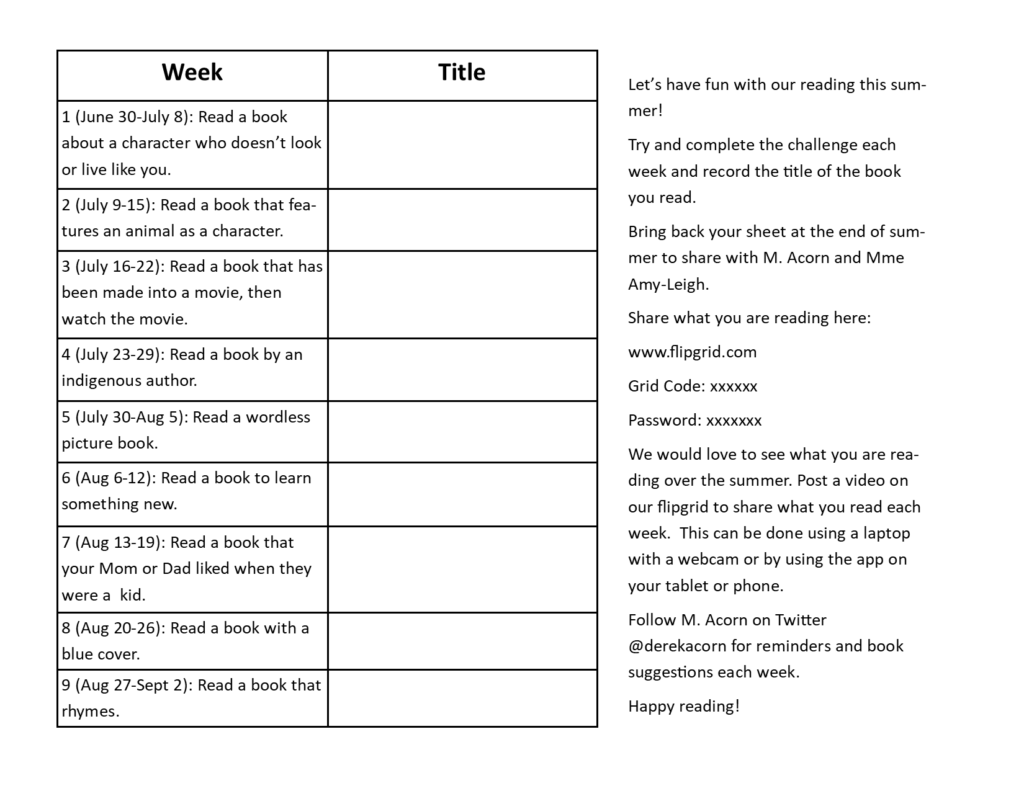
By Derek Acorn
As school librarians and teacher-librarians we all want to help our students keep reading over the summer and avoid the dreaded summer slide. The problem we face is how to reach students and families when they are out of school for the summer? This is where social media and digital tools can be incredibly useful to extend our reach into our students’ homes during summer.
The Beginning
I am the teacher-librarian at two French Immersion K-8 schools in the Louis Riel School Division in Winnipeg, Manitoba. In collaboration with my library assistants, Amy-Leigh Gray (École Varennes) and Lise Sokal (École Marie-Anne Gaboury), we began by developing the themes for two different groups: K-3 and 4-8. There is some crossover between the themes for the two groups, but also some differences that allow for the variance in reading levels of these groups.
We tried to keep the themes quite general to give as much choice as possible to the reader. Themes such as “read a book with a blue cover” allow for a lot of flexibility for the reader to choose a book from a variety of genres and styles.


Low-Tech Promotion
Once we established the theme for each week we moved into the promotion portion of our program. We used a combination of low-tech and high-tech approaches to reach our families in multiple ways. We wanted to be sure that every one of our families was informed about the program in multiple ways to ensure that the information was received and understood.
To begin, every student received a hard copy of the Summer Reading Challenge themes, as well as a recording sheet on the backside to help track what they were reading. We also provided additional details about the program on the back side to help families engage with our online tools.

The same document was emailed to all our families. This again allowed for a greater reach than simply the hard copy sheet that was sent home with the student. It also allowed us to attach further details about the program, such as how to access the digital tools and my Twitter handle to follow to receive updates and reminders over the summer.
Using Twitter to Promote the Program
It is all well and good to inform families about the Summer Reading Challenge in June. Our concern was how to keep up the momentum over the summer months. We decided to leverage social media by using Twitter as our platform. By using Twitter we could continue to reach our families and students over the summer through their smartphones, tablets or home computers.
At the beginning of each week, we tweeted to our K-3 audience as well as our 4-8 audience. Our tweets included a reminder of the theme of the week plus an embedded video that gave examples of books that might fit that theme. We felt it was important to give some concrete example of books for families that might be unfamiliar with the week’s theme and/or would be visiting a library to borrow books to fit the theme. By giving some examples we provided a starting point for anyone looking for suggestions for what to read that week.
We tried to keep the videos to under two minutes so that the viewer did not lose interest, although I got carried away with my examples a couple of times and exceeded two minutes. The format of our videos was simple:
- A reminder of the theme of the week
- Examples and brief summaries of books that fit the theme
- A reminder to record their reading to share with us in September and/or to use our Flipgrid to share (more details on this to come)
This promotional tool was successful as we consistently reached over 100 views and often exceeded 200 views. Considering the fact that my two schools have a combined population of around 775 students, that is a solid number of families that were reached each week.
Using Flipgrid to Share Our Reading
Flipgrid was the second online tool that we used to help enhance our Summer Reading Challenge. Flipgrid is an online video discussion platform that allows educators to create topic grids in which students post video responses to specific prompts. They can respond to each other and add details such as stickers to personalize their responses. This all takes place within a password protected environment, which increases the safety of the platform. If you have never checked out Flipgrid I would encourage you to take a look. Best of all, it is free!
We set up a grid for each week of the challenge and asked that students/families share what they were reading that week. The idea was for these grids to become a place for sharing, but also a place of discovery. By participating, students and families would not only have the chance to share what they were reading, they would have the chance to discover all kinds of new books that others were reading in that week’s theme.
As well-intentioned as this part of the Summer Reading Challenge was, it was ultimately not very successful. There were not many responses posted or many views of the videos that were posted. I believe the biggest factor was lack of familiarity with the platform. It is a fairly new site/app, and many parents and students have not been exposed to it as of yet. If I were to do this again, I would do some tutorials with the students prior to summer break and also tweet or send out a video tutorial on how to use Flipgrid.
Reflections
I believe there were many successful elements to our approach for our Summer Reading Challenge, including:
- Keeping the themes loose enough to allow choice for the reader
- Keeping students connected to school and literature over the summer by reaching out to them on Twitter and Flipgrid
- Using social media as a tool for communication and promotion
- Challenging students to read a variety of genres and types of text over the summer
- Getting families involved in their child’s reading
- Providing examples of books that fit each theme in our weekly videos
What will I change for next year?
- I will begin the process earlier to allow for more promotion both within the school and with families at home.
- I want to increase the use of Flipgrid as a tool for sharing our reading, so I will be creating How-to guides and online tutorials to make sure the tool is more accessible and understood.
- Last year our local library was closed for renovations, so I was unable to connect with them. This year I would like to make that connection so that our students are aware and can access books from the public library over the summer.
- I would like to get the staff more involved next year. I was laser focused on the students this year, but I think I missed an opportunity to keep staff connected to the students over the summer through this program.
Overall, I believe what we achieved this year was a good start, but that there is still room for improvement. I would encourage other school libraries to use online tools to maximize their reach over the summer months and create that link between school and home.
Summer Reading Outreach with Twitter: Three Examples
Week 1
Week 2 of our Summer Reading Challenge @varennesLRSD and @magLRSD starts tomorrow! For K-3, the challenge this week is to read a book that features an animal as a character. Don’t forget to share what you’re reading on our Flipgrid. pic.twitter.com/oPhejn7X8y
— Derek Acorn (@derekacorn) July 9, 2018
Week 5
Time for Week 5 of our Summer Reading Challenge @varennesLRSD and @magLRSD. The challenge for Grades 4-8 students this week is to read a graphic novel. Don’t forget to share on our Flipgrid. pic.twitter.com/gRq56f36bV
— Derek Acorn (@derekacorn) July 31, 2018
Week 8
Time for Week 8 of our Summer Reading Challenge @varennesLRSD and @magLRSD. The challenge for K-3 students this week is to read a book with a blue cover. Don’t forget to share on our Flipgrid. pic.twitter.com/cUDfGT1GoQ
— Derek Acorn (@derekacorn) August 20, 2018

Derek Acorn is the teacher-librarian at two K-8 French Immersion schools (École Marie-Anne Gaboury and École Varennes) in the Louis Riel School Division in Winnipeg, Manitoba. He is passionate about Project Based Learning, technology integration and helping students develop their love of reading. As a reader, he loves middle grade and YA novels, especially realistic fiction and graphic novels.